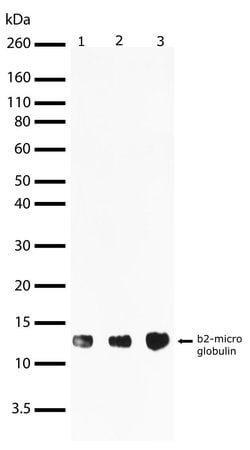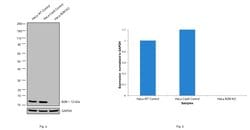Learn More
Invitrogen™ beta-2 Microglobulin Recombinant Superclonal™ Antibody (4HCLC)
Rabbit Recombinant Superclonal Antibody
Supplier: Invitrogen™ 710274
Description
This antibody is predicted to react with non-human primate, mouse and rat based on sequence homology. Recombinant rabbit Superclonal™ antibodies are unique offerings from Thermo Fisher Scientific. They are comprised of a selection of multiple different recombinant monoclonal antibodies, providing the best of both worlds - the sensitivity of polyclonal antibodies with the specificity of monoclonal antibodies - all delivered with the consistency only found in a recombinant antibody. While functionally the same as a polyclonal antibody - recognizing multiple epitope sites on the target and producing higher detection sensitivity for low abundance targets - a recombinant rabbit Superclonal™ antibody has a known mixture of light and heavy chains. The exact population can be produced in every lot, circumventing the biological variability typically associated with polyclonal antibody production. Note: Formerly called Recombinant polyclonal antibody, this product is now rebranded as Recombinant Superclonal™ antibody. The physical product and the performance remain unchanged.
Beta-2-microglobulin (B2M) is a 12-14 kDa protein that is a subunit of the major histocompatibility complex (MHC) class I. Human beta 2 Microglobulin associated with HLA Class I antigens are expressed on many types of cells including lymphocytes, thymocytes, monocytes, granulocytes, platelets, endothelial cells, and epithelial cells, but is absent on erythrocytes. Beta-2 microglobulin is also found in free form in the plasma. The amino acid sequence of Beta-2-microglobulin is homologous to the constant regions of immunoglobulin heavy and light chains, with a predominantly beta pleated sheet structure. The protein is ubiquitously expressed in the cytoplasm, and is involved in antigen processing and presentation. Beta-2-microglobulin also plays a role in TCR signaling, and downstream signaling in naive CD8+ cells. Beta 2-microglobulin is encoded by the B2M gene located on chromosome 15. A mutation in the Beta-2-microglobulin gene has been shown to result in hypercatabolic hypoproteinemia. Levels of beta 2 microglobulin can be used to assess renal function in kidney transplant recipients. Beta-2-microglobulin that protein can be used as a prognostic marker for HIV infection.
Specifications
| beta-2 Microglobulin | |
| Recombinant Superclonal | |
| 0.5 mg/mL | |
| PBS with 0.09% sodium azide | |
| P61769 | |
| B2m | |
| Recombinant protein corresponding to amino acids 21-119 of human b2-microglobulin. | |
| 100 μg | |
| Primary | |
| Human | |
| Antibody | |
| IgG |
| Western Blot | |
| 4HCLC | |
| Unconjugated | |
| B2m | |
| B2m; B2-microglobulin; b2m-W01; b2m-W03; b2m-Z01; b2m-Z02; b2m-Z03; Beta 2 microglobin; Beta 2 microglobulin; beta 2-microglobulin; beta chain of MHC class I molecules; Beta2 microglobulin; beta-2 microglobulin; beta-2 microglobulin preprotein; beta2m; beta2-m; beta-2-microglobin; beta-2-microglobulin; beta-2-microglobulin C-terminal fragment (55 AA); Beta-2-microglobulin form pI 5.3; B-F; CDABP0092; HDCMA22P; IMD43; Lactollin; Ly-m11; MHC Class I; microglobulin beta-2; Orla-B2m | |
| Rabbit | |
| Protein A | |
| RUO | |
| 567 | |
| Store at 4°C short term. For long term storage, store at -20°C, avoiding freeze/thaw cycles. | |
| Liquid |
Your input is important to us. Please complete this form to provide feedback related to the content on this product.

